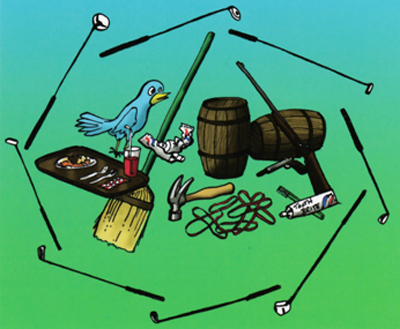Great Teaching Analogies
 Using analogies to help teach golf students is commonplace, and it has been for years. Students can learn plenty when you pass along improvement techniques through everyday and non-technical means. Do you use them? If not, you should. Here’s a brief look at some of the most popular analogies of all time.
Using analogies to help teach golf students is commonplace, and it has been for years. Students can learn plenty when you pass along improvement techniques through everyday and non-technical means. Do you use them? If not, you should. Here’s a brief look at some of the most popular analogies of all time.
Percy Boomer – Turn in a Barrel
One of the earliest golf teaching “gurus” gave the golf world one of its most lasting analogies. Percy Boomer, one of the great instructors from the early part of the century – he taught the likes of Harry Vardon and Ted Ray at the St. Cloud Club near Paris – was a “feel” guy. Rather than having a student understand the swing mechanics, Boomer preferred to teach by the pupil’s sense of feel. And, his “turn in a barrel” analogy helped the golfer achieve the sensation of turning while not swaying. Although steel-shafted clubs, and the “modern” swing of Byron Nelson with its steeper plane, altered the philosophy to slightly more lateral motion (today players are generally taught to get more behind the ball, which doesn’t entirely mesh with this “image”), the “turn in a barrel” analogy is still widely used to eliminate slides.
Cary Middlecoff – The Swing is a Wheel
With himself as the hub, Middlecoff liked to imagine his golf swing simulating a wheel lying at about a 45° angle to the ground. The club, hands, and arms all go back in one clearly-defined track and return to the ball on that same track. As you swing the golf club, the radius of your swing, which is measured by the distance between your chest and the butt end of the club, remains constant. This fine analogy, when “felt” correctly, provides width, speed, and arm/body connection in the swing. If the radius changes, the “wheel” collapses and the swing breaks down. Sam Snead once said that “if someone has a consistent plane, back and through, they have a swing.” I’m sure Middlecoff would have agreed.
Horace Hutchinson – Play Golf Like Billiards
The simple premise of this tip – leave yourself in perfect position to play the next shot – is as valid today as it was when Hutchinson recommended it in 1912. Millions of recreational golfers rarely, if ever, choose proper angles and correct yardages to set up their next shot. Golf holes are generally designed to favor an approach from one side of the fairway. Greens should be “missed” on the appropriate side. Chips should be left in the proper position below the hole. In other words, good course management – and following Hutchinson’s advice – would serve every golfer well. We should teach more about the “art” of playing to our students.
Davis Love Jr. – Shake Hands With Someone On Your Right
On the takeaway, Love wanted the golfer to feel the proper amount of forearm rotation. This analogy provided just that. Most golfers would do much better if their forearm rotation would occur when the hands are at or below hip level. This tip helps facilitate that. And, in conjunction, it also keeps the clubface square and the shaft on the proper plane. Too much rotation and the club is laid off; too little rotation and the clubface remains closed, and the arms will easily become “separated” or “disconnected” from the body. This is a simple analogy that can do wonders for the clubface and the plane of the swing.
Eddie Merrins – Make a Pistol with Your Left Hand
Somebody once said that in golf, “your wrists are the clubface.” In other words, change your wrist formation and you automatically change the clubface. Eddie Merrins, one of the most respected golf instructors the game has ever known (he’s still teaching at Bel-Air Country Club in Los Angeles), provided golfers with a very simple analogy for the proper use of the wrists. He likes to have golfers make a “pistol” with their left hand, with the index finger the barrel and the thumb the hammer. He then has them pull directly back on the hammer in the direction of the forearm and cock their wrist. This gives the golfer the proper action in setting the wrists. But not only that, this great analogy increases leverage and speed in the swing, and keeps the clubface square throughout the motion. Because, at the moment of truth, the position – and speed – of the clubface is just a wee bit important. Obviously, there have been other great analogies used throughout the history of the game. Perhaps you’ve got a favorite you “pull out of the bag” from time to time. Or, better yet perhaps, one day you’ll be famous for coining your own




